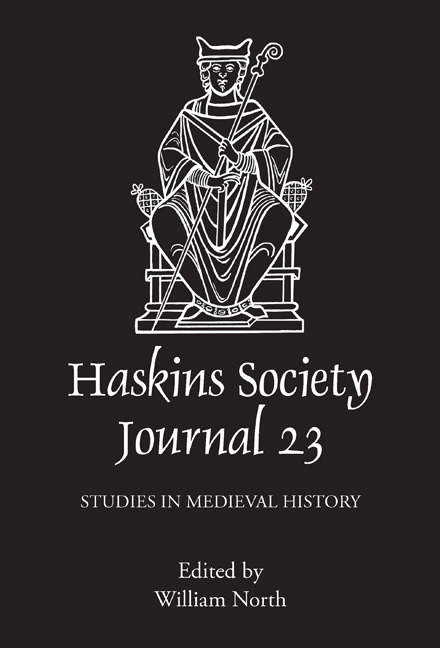Book contents
- Frontmatter
- Contents
- List of Figures
- Editor's Note
- Abbreviations
- 1 Francia and the History of Medieval Europe
- 2 Royal Control and the Disposition of Estates in Tenth-Century England: Reflections on the Charters of King Eadwig (955–959)
- 3 Denis Bethell Prize Essay: Frutolf of Michelsberg's Chronicle, the Schools of Bamberg, and the Transmission of Imperial Polemic
- 4 Manipulating Historical Memory: Cosmas on the Sees of Prague and Olomouc
- 5 Poetry and History: Baudry of Bourgueil, the Architecture of Chivalry, and the First Crusade
- Authors' Preface to Chapters 6 and 7
- 6 Men and Masculinities at the Courts of the Anglo-Norman Kings in the Ecclesiastical History of Orderic Vitalis
- 7 Men and Masculinities in William of Malmesbury's presentation of the Anglo-Norman Court
- 8 The Personnel of Comital Administration in Greater Anjou, 1129–1151
- 9 The Murder of Gilbert the Forester
- 10 The Object as Subject in Medieval Art
7 - Men and Masculinities in William of Malmesbury's presentation of the Anglo-Norman Court
Published online by Cambridge University Press: 05 November 2014
- Frontmatter
- Contents
- List of Figures
- Editor's Note
- Abbreviations
- 1 Francia and the History of Medieval Europe
- 2 Royal Control and the Disposition of Estates in Tenth-Century England: Reflections on the Charters of King Eadwig (955–959)
- 3 Denis Bethell Prize Essay: Frutolf of Michelsberg's Chronicle, the Schools of Bamberg, and the Transmission of Imperial Polemic
- 4 Manipulating Historical Memory: Cosmas on the Sees of Prague and Olomouc
- 5 Poetry and History: Baudry of Bourgueil, the Architecture of Chivalry, and the First Crusade
- Authors' Preface to Chapters 6 and 7
- 6 Men and Masculinities at the Courts of the Anglo-Norman Kings in the Ecclesiastical History of Orderic Vitalis
- 7 Men and Masculinities in William of Malmesbury's presentation of the Anglo-Norman Court
- 8 The Personnel of Comital Administration in Greater Anjou, 1129–1151
- 9 The Murder of Gilbert the Forester
- 10 The Object as Subject in Medieval Art
Summary
In the latter years of Henry I's reign, one of his knights (milites) experienced a troublesome dream. Whilst asleep he dreamt that his long, luxurious hair was strangling him. He was so unnerved by this vision that upon waking he promptly had it all cut off. The knight (miles) was apparently one of a number of long-haired men who, forgetful of their natural sex, had wished to grow their hair long in order to look like women. This dream episode and subsequent hair-cutting is reported by the twelfth-century Benedictine monk William of Malmesbury. Malmesbury goes on to comment that as a result of this dream many others also had their hair cut but that it was a short-lived fashion. Indeed, according to Malmesbury, barely a year had passed before:
… all who regarded themselves as courtiers (curiales) relapsed into their old faults. They vied with women (feminis) in the length of their locks, and when, the hair was inadequate, they fastened on a kind of hair-piece, forgetting, or rather not knowing, the Apostle's judgement, ‘If a man has long hair, it is to his shame.’
Malmesbury's explicit use of gendered imagery raises a whole series of questions. Men are here compared to women with their long flowing hair in a way that makes clear that this is not how men should act.
- Type
- Chapter
- Information
- The Haskins Society Journal 232011. Studies in Medieval History, pp. 115 - 124Publisher: Boydell & BrewerPrint publication year: 2014



